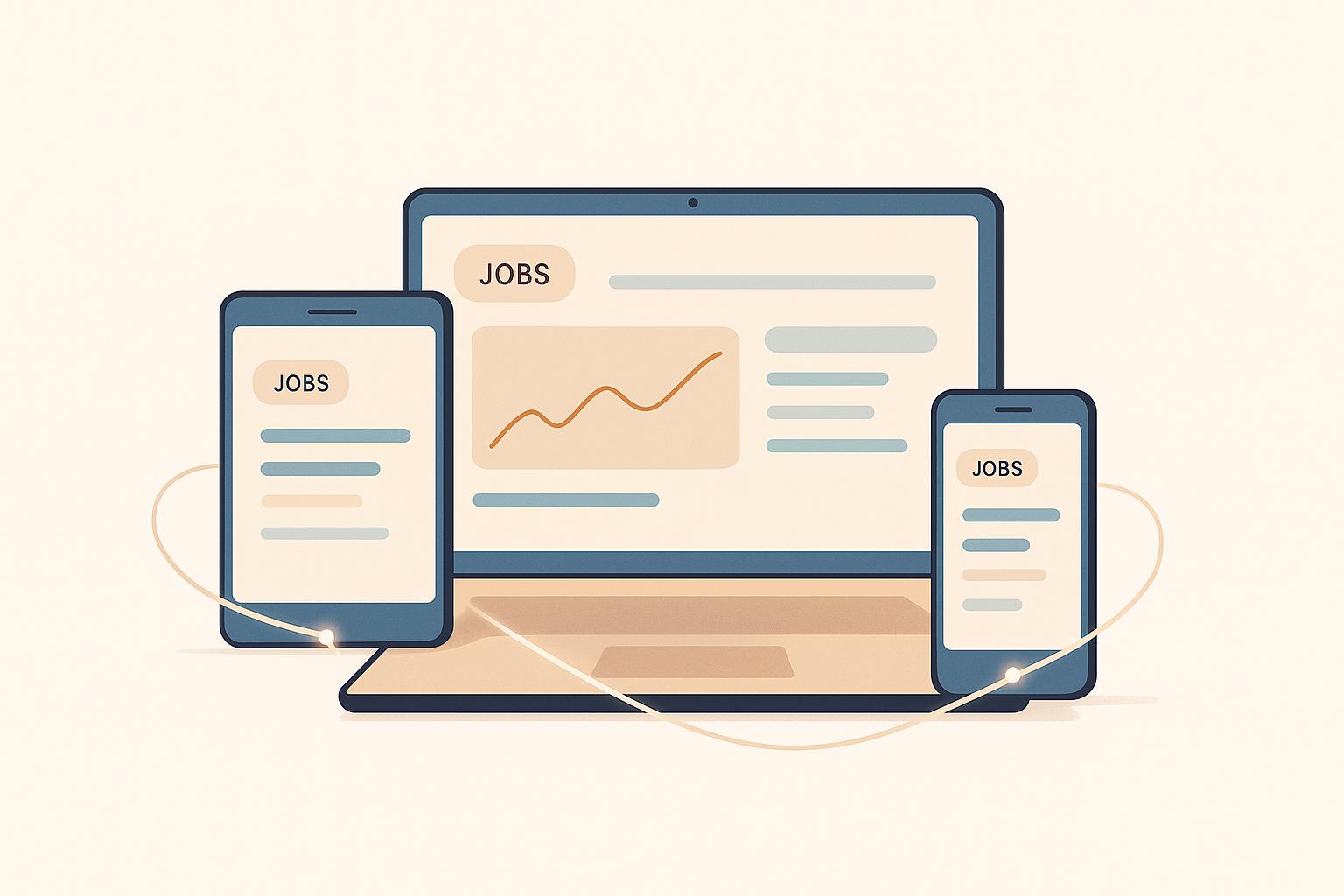Want to stand out in the job market? A technical portfolio can prove your skills better than a resume. Here’s why and how to build one:
- Why It Matters: 59% of hiring managers prefer portfolios over resumes. They look for problem-solving abilities (60%), diverse projects (70%), and clean, well-documented code (80%).
- What to Include: Feature 3–5 projects that demonstrate technical expertise, problem-solving, and industry relevance. Use metrics like "40% faster load time" or "$50,000 cost savings" to highlight results.
- How to Organize: Keep it clear and accessible. Use concise descriptions, visuals (screenshots, diagrams), and accessible features like readable fonts and captions.
- Prove Your Skills: Add certifications, live demos, and working examples. Employers value verified credentials and real-world applications.
- Leverage AI: Tools like JobSwift.AI can optimize your portfolio for ATS systems, aligning your skills with job requirements.
A strong portfolio isn’t just a showcase - it’s proof of your capabilities. Start building or refining yours today to make a lasting impression.
How To Build a Tech Portfolio | Part 1: Structure and Style with HTML and CSS
Select Strong Portfolio Projects
Choosing the right projects for your technical portfolio is a key step in showcasing your expertise and problem-solving skills. Your portfolio should not only reflect your technical abilities but also highlight your capacity to tackle challenges effectively.
How to Pick the Best Projects
When deciding which projects to include, focus on those that demonstrate:
- Problem-solving skills: Highlight projects where you’ve addressed complex challenges. This matters - a survey shows that 85% of hiring managers prioritize candidates with strong problem-solving abilities.
- Technical expertise: Include work that showcases your mastery of relevant tools, frameworks, or programming languages.
- Relevance to the industry: Choose projects that reflect current technologies and practices, aligning with the roles you’re targeting.
Aim to feature 3–5 projects that showcase a range of skills. For example, if you’re targeting full-stack roles, include projects that demonstrate front-end, back-end, and database skills. A mix of professional and personal projects will give a fuller picture of your abilities.
Mix Personal and Work Projects
Once you’ve identified your strongest work, balance your portfolio with a combination of personal and professional projects. Emilie Tardivel, Artist's Agent & Producer, emphasizes:
"Personal work can be as important as commercial projects to secure more projects! Make sure what you share with the world is the type of work you enjoy doing and want to do more of."
For professional projects, keep these points in mind:
- Respect confidentiality agreements.
- Highlight your specific contributions to the project.
- Include links to public-facing elements, if available.
Personal projects are a great way to fill in gaps left by your professional work. They allow you to demonstrate skills or experiment with technologies you haven’t used in a work setting. You might even consider creating a separate "playground" section in your portfolio for experimental or creative work, showing your enthusiasm for learning and innovation.
Show Project Results with Numbers
To make your portfolio stand out, include measurable outcomes for your projects. Use specific metrics to quantify your achievements:
| Metric Type | Example Measurements |
|---|---|
| Performance | 40% reduction in load time, 99.9% uptime |
| Scale | Supported 100,000+ daily active users |
| Efficiency | Automated processes saving 20 hours/week |
| Impact | $50,000 in annual cost savings |
Whenever possible, include pre- and post-performance metrics, engagement stats, or business impact figures. Numbers provide tangible proof of your contributions and make your work more compelling.
Also, ensure your project repositories are accessible and include clear documentation. This is crucial - 80% of top employers value clean, well-documented code. Take the time to make your documentation thorough and user-friendly.
Finally, keep your portfolio fresh by updating it regularly. Rafik El Hariri, Illustrator/Artist, advises:
"Quality Over Quantity. It is much better to showcase 5 ideal projects that shows your creative 'muscle' rather than showing 10-15 miscellaneous projects that would blur out your area of expertise or strong skillset."
Build a Clear Technical Portfolio
Organizing your technical portfolio effectively can make all the difference in showcasing your skills. Studies indicate that 75% of users prefer clear documentation, so clarity should be a top priority when presenting your work.
Layout for Technical Readers
Your portfolio layout should cater to technical recruiters and hiring managers, making it easy for them to find the information they need. Consider including a sticky navigation bar with these sections: About, Projects, Contributions, and Contact.
Here are some tips to keep your layout clean and effective:
- Use concise project descriptions - stick to 2–3 bullet points per project.
- Organize content with clear headings and subheadings.
- Include a glossary for any specialized terms.
- Maintain consistent formatting throughout.
When presenting technical details, aim for a balance: 40% text and 60% visuals. This ratio helps keep readers engaged.
Add Technical Images and Docs
Visual elements are a powerful way to communicate your work, as they are processed much faster than text. For each project, include:
- Screenshots that highlight key user interface elements.
- Architecture diagrams to explain system workflows.
- Short video demos or GIFs to showcase functionality.
- Visualizations of performance metrics to illustrate results.
"Personal work can be as important as commercial projects to secure more projects! Make sure what you share with the world is the type of work you enjoy doing and want to do more of."
Make Your Portfolio Work for Everyone
Accessibility ensures your portfolio is usable by the widest possible audience. Here’s how you can achieve that:
| Accessibility Feature | Implementation Guide | Impact |
|---|---|---|
| Font Selection | Use Arial or Open Sans at 16px | Improves readability across devices |
| Color Contrast | Follow WCAG AA compliance | Ensures text is easily visible |
| Navigation | Enable full keyboard access with visible focus | Supports assistive technology users |
| Media Content | Provide captions and transcripts | Makes content accessible to hearing-impaired users |
sbb-itb-96bfd48
Prove Your Technical Skills
Once your portfolio is organized, it’s time to back it up by showcasing your technical skills with evidence that can be verified. According to recent data, 95% of employers believe microcredentials on a resume enhance a candidate's appeal.
Show Your Certificates
Digital credentials have become a powerful way to highlight your qualifications. Here’s how you can effectively showcase your certifications:
| Credential Type | Display Method | Verification Method |
|---|---|---|
| Technical Certifications | Direct LinkedIn integration | Automated verification link |
| Industry Badges | Digital badge showcase | Blockchain verification |
| Course Completions | Skills section mapping | Certificate URL |
To make your certifications stand out:
- Pin the most relevant ones at the top of your portfolio.
- Embed verification links in your summary or project descriptions.
- Group related credentials to highlight expertise in specific areas.
- Regularly update expired certifications to maintain credibility.
"Digital badges and credentials -- which are issued by organizations who can validate our accomplishments -- are an essential element in telling the story of who we are and what we can offer." - Credly
After sharing your certifications, take it a step further by showing how you’ve applied those skills in real-world scenarios.
Include Working Examples
Demonstrating your skills through working examples is one of the most persuasive ways to validate your expertise. For instance, a self-taught developer landed a job by redesigning a major news website, complete with interactive demos and detailed documentation.
To make your examples impactful:
- Create interactive demos using testing environments.
- Link to live projects so employers can see your work in action.
- Show before-and-after comparisons to highlight improvements.
- Document your process to explain your approach and decisions.
"If you make fake projects, the trick is to make it look real. Put it in context: Print it out and photograph it, mock it up however you need to as if it were really a finished product and not just comps/ideas." - Katie Kovalcin, Design Lead at Gusto
Compare to Industry Standards
Stacking your skills against industry benchmarks can further highlight your expertise. The World Economic Forum notes that 50% of the global workforce will need new skills to adapt to shifts caused by emerging technologies.
You can create a skills comparison matrix like this:
| Skill Area | Your Proficiency | Industry Standard | Gap Analysis |
|---|---|---|---|
| Technical Knowledge | Advanced certification | Required certification | Exceeds standard |
| Implementation | Project examples | Industry benchmarks | Meets standard |
| Problem-solving | Case studies | Expected outcomes | Demonstrates expertise |
To stay ahead, regularly enhance your skills through:
- Attending industry events
- Completing technical training programs
- Expanding your professional network
- Applying new knowledge to projects
Use AI to Improve Your Portfolio
AI technology is reshaping how professionals enhance their portfolios, particularly in technical fields. Consider this: 80% of resumes fail initial screenings due to ATS (Applicant Tracking System) inefficiencies. This makes AI-powered portfolio optimization more important than ever.
AI-Powered Skill Matching
AI has revolutionized how skills are matched to job requirements. Unlike older systems that relied solely on keywords, modern AI tools can understand the context and relationships between skills, ensuring a more accurate and impactful presentation of your expertise.
| Matching Aspect | Traditional Method | AI-Driven Method |
|---|---|---|
| Skill Analysis | Keyword matching | Contextual understanding |
| Experience Evaluation | Manual review | Automated semantic analysis |
| Technical Mapping | Basic matching | ESCO framework integration |
| Skill Relevance | Binary yes/no | Weighted relevance scoring |
To make your portfolio AI-friendly:
- Organize your skills in a clear and logical format.
- Use industry-specific terms that align with the roles you’re targeting.
- Map your skills to established frameworks like ESCO.
- Emphasize measurable achievements that AI systems can easily interpret.
By refining your skills and structuring your portfolio for AI compatibility, you’ll position yourself more effectively for job opportunities.
Connect Portfolio to Applications
Tools like JobSwift.AI simplify the process of aligning your portfolio with job applications. These platforms use AI to ensure your materials meet ATS standards, giving you an edge in the hiring process.
Here’s how to make the most of these tools:
- Optimize for ATS: Structure your portfolio to meet ATS requirements while keeping it reader-friendly.
- Ensure Skill Consistency: Present your technical skills consistently across your portfolio and applications. This is vital, as 95% of employers report that AI-driven systems significantly reduce hiring timelines.
"Gone are the days of spray and pray for both sides of the equation. We know that sending an application to hundreds of jobs or sending messages to hundreds of mismatched candidates only prolongs the process of actually finding a job."
- Raj Mukherjee, executive vice president and general manager at Indeed
The benefits of AI optimization are clear. For example, recruiters now save an average of 8.1 hours per week thanks to AI-driven tools. By integrating these strategies, you’ll not only streamline your job search but also make a stronger impression on potential employers.
Conclusion: Create an Effective Technical Portfolio
In today’s job market, technical portfolios are no longer optional - 59% of hiring managers now favor them over traditional resumes. A well-crafted portfolio goes beyond listing skills; it showcases your technical abilities and problem-solving prowess through real-world impact, such as performance boosts, user engagement growth, or cost reductions.
"A resume says you have certain skills, the portfolio proves it." - Tech Elevator
What makes a technical portfolio stand out? Let’s break it down:
| Key Portfolio Elements | Impact on Hiring | Best Practice |
|---|---|---|
| Project Showcase | 80% of hiring managers spend under 3 minutes reviewing | Feature 3–4 standout projects with measurable results |
| Technical Documentation | Highlights attention to detail | Include architecture diagrams and relevant code snippets |
| Problem-Solving | Demonstrates practical application | Explain challenges faced, your approach, and the outcomes |
| Skills Validation | Builds trust and credibility | Link certifications and provide live demos or working project examples |
Keeping your portfolio updated is key to reflecting your growing expertise. As you acquire new skills or complete projects, make sure your portfolio evolves alongside you. Regular updates ensure it stays relevant and aligned with your job search goals.
For each project, focus on telling a story: outline the initial problem, detail your technical approach, and emphasize measurable outcomes. To get an edge, consider tools like JobSwift.AI (https://jobswift.ai) to seamlessly integrate your portfolio with job applications, increasing your visibility to recruiters in a competitive market.
FAQs
How can I effectively showcase both personal and professional projects in my technical portfolio?
To build an engaging and well-rounded technical portfolio, focus on blending personal and professional projects that showcase your skills and adaptability. Prioritize quality over quantity - select projects that truly highlight your expertise, creativity, and problem-solving capabilities.
For personal projects, choose ones that reflect your enthusiasm and initiative. These can demonstrate your ability to think independently and explore new ideas. On the other hand, professional projects should illustrate your ability to deliver tangible results in a workplace environment. For each project, provide clear details about your role, the tools and technologies you used, and the outcomes you achieved. This makes it easy for potential employers to grasp your contributions and the value you can offer.
By curating a portfolio that’s diverse yet unified, you’ll not only demonstrate your technical skills but also convey a strong sense of your personal brand.
What are the best ways to use AI tools to enhance my technical portfolio for job applications?
To make the most of AI tools for enhancing your technical portfolio, start by using platforms designed to create sleek and professional designs. These tools can help you save time while ensuring your portfolio is visually appealing and effectively showcases your technical expertise.
You can also tap into AI-powered tools to analyze job descriptions and tailor your portfolio to match the skills and qualifications employers are seeking. By aligning your projects and experiences with specific job postings, you’ll increase your chances of grabbing a recruiter’s attention.
Lastly, explore generative AI to add a touch of interactivity to your portfolio. Think about incorporating dynamic visualizations or interactive demos of your work. These features make it easier for recruiters to understand the value you bring and leave a lasting impression. Using these AI-driven approaches can streamline your job search and make your portfolio stand out in a crowded field.
How can I select the best metrics to highlight the impact of my projects in my portfolio?
To highlight your project's impact effectively, start by aligning your chosen metrics with the specific goals and outcomes of the project. Incorporate quantitative metrics like cost reductions, the percentage of milestones achieved, or time saved compared to original estimates. These figures provide a clear, measurable way to showcase your efficiency.
For a well-rounded approach, add qualitative insights such as customer feedback, stakeholder satisfaction, or user testimonials. Combining hard data with personal perspectives creates a compelling narrative that resonates with potential employers. This blend of metrics not only demonstrates the results you deliver but also sets your portfolio apart by emphasizing the real-world value you bring to your projects.


